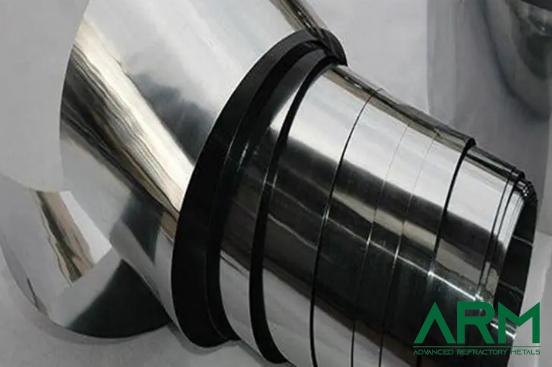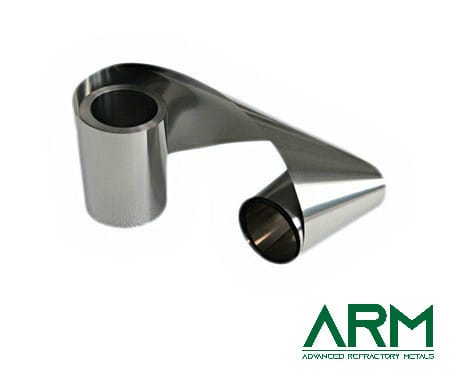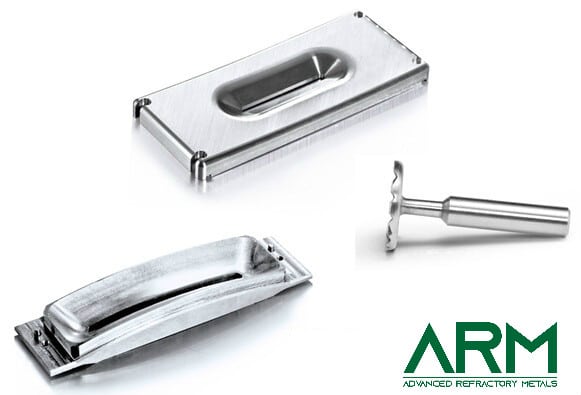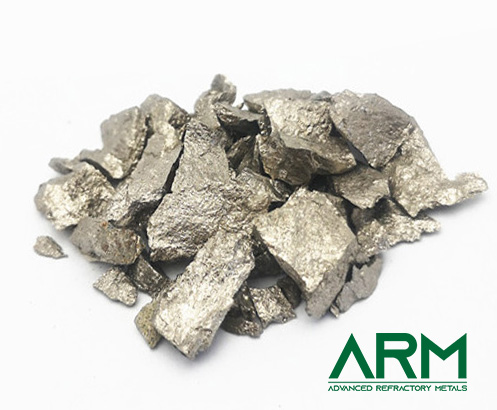(Discontinued) ZR0902 Zirconium Foil (Zr Foil)
Zirconium (Zr) foil, strip, and ribbon from Stanford Advanced Materials (SAM) are made from high-purity metal or alloys. Advanced rolling and precise annealing deliver smooth surfaces, uniform structure, and excellent tear resistance. For thicknesses over 0.5 mm, see our zirconium plate and sheet.
Descriptions of Zirconium Foil
Zirconium metal and Zirconium alloys has advantages in specialized chemical environments - primarily acetic and hydrochloric acids. The corrosion resistance of Zirconium comes from a tightly adhered oxide that forms almost instantaneously. As a result, zirconium has been used to make electrodes components, foils, flanges bolts, tubes and rods for special applications.
Advanced Refractory Metals is a leading supplier and manufacturer of zirconium foil and a wide variety of Zirconium products. Customized forms are available upon request.
Specifications of Zirconium Foil
| Material | Zr702, Zr704, Zr705, |
| Thickness | 0.01mm-0.3mm |
| Width | <300mm |
| Length | 10~20m |
Composition of Zirconium materials
| Zr 702 | Zr 704 | Zr 705 | Zircaloy-2 | Zircaloy-4 | |
| Sn | / | 1~2% | 1~2% | 1.2~1.7% | 1.2~1.7% |
| Fe | <0.05% | 0.1~0.2% | <0.05% | 0.07~0.2% | 0.07~0.2% |
| Cr | <0.05% | 0.1~0.2% | <0.01% | 0.05~0.15% | 0.05~0.15% |
| Ni | / | / | / | 0.03~0.08% | <0.007% |
| Hf | 2.5~4.5% | <4.5% | <4.5% | ||
| Nb | / | / | 2~3% | ||
| Zr+Hf | ~99.2% | ~97.5% | ~95.5% | ~98% | ~98% |
Physical Properties
| Material | State | Rm(≥)/MPa | Rp0.2(Pa | A50mm(≥)/% |
|
Zirconium 702 (UNS R60702) |
annealed | 379 | 207 | 16 |
|
Zirconium 704 (UNS R60704) |
annealed | 413 | 241 | 14 |
|
Zirconium 705 (UNS R60705) |
annealed | 552 | 379 | 16 |
Here’s a concise and clear version of the Zirconium Foil/Strip/Ribbon Production Process:
Zirconium Foil/Strip/Ribbon Manufacturing
Zirconium foil, strip, and ribbon are produced from high-purity ingots through controlled rolling and heat treatment steps to achieve precision thickness and mechanical performance. The typical process includes:
-
Raw Material Selection – High-purity zirconium ingots or powder are chosen based on quality standards.
-
Melting & Casting – Zirconium is melted in a vacuum or inert gas and cast into ingots.
-
Hot Rolling – Ingots are heated and rolled to reduce thickness and shape the material.
-
Cold Rolling – Thickness is further reduced at room temperature for better finish and strength.
-
Annealing – Heat treatment relieves stress and enhances ductility.
-
Pickling & Polishing – Surfaces are chemically cleaned and polished to remove oxides.
-
Final Cutting – Material is trimmed into foil, strip, or ribbon to meet application needs.
This precise process ensures optimal properties for use in electronics, nuclear, and chemical industries.
Applications of Zirconium Foil
* Used to make high-temperature superconductive materials.
* Used to make electrodes components, foils, flanges bolts, tubes and rods for special applications.
* Zirconium alloys are also considered to be promising materials for commercial amorphous metal, also called metallic glass. Compared with common metal materials, amorphous metal has no grain boundaries, leading to better wear resistance and hardness.
* Zirconium foil has wide applications in medical equipment, such as zirconium implants.
Packaging of Zirconium Foil
Our Zirconium foil is carefully handled to prevent damage during storage and transportation and to preserve the quality of our product in its original condition.
- Your Name (required)
- Your Email (required)
- Company Name (required)
-
Country (required)
United States
- United States
- Afghanistan
- Aland Islands
- Albania
- Algeria
- American Samoa
- Andorra
- Angola
- Anguilla
- Antarctica
- Antigua and Barbuda
- Argentina
- Armenia
- Aruba
- Australia
- Austria
- Azerbaijan
- Bahamas
- Bahrain
- Bangladesh
- Barbados
- Belarus
- Belgium
- Belize
- Benin
- Bermuda
- Bhutan
- Bolivia
- Bosnia and Herzegovina
- Botswana
- Bouvet Island
- Brazil
- British Indian Ocean Territory
- British Virgin Islands
- Brunei
- Bulgaria
- Burkina Faso
- Burundi
- Cambodia
- Cameroon
- Canada
- Cape Verde
- Cayman Islands
- Central African Republic
- Chad
- Chile
- China
- Christmas Island
- Cocos (Keeling) Islands
- Colombia
- Comoros
- Congo
- Cook Islands
- Costa Rica
- Croatia
- Cuba
- Cyprus
- Czech Republic
- Democratic Republic of Congo
- Denmark
- Disputed Territory
- Djibouti
- Dominica
- Dominican Republic
- East Timor
- Ecuador
- Egypt
- El Salvador
- Equatorial Guinea
- Eritrea
- Estonia
- Ethiopia
- Falkland Islands
- Faroe Islands
- Federated States of Micronesia
- Fiji
- Finland
- France
- French Guyana
- French Polynesia
- French Southern Territories
- Gabon
- Gambia
- Georgia
- Germany
- Ghana
- Gibraltar
- Greece
- Greenland
- Grenada
- Guadeloupe
- Guam
- Guatemala
- Guinea
- Guinea-Bissau
- Guyana
- Haiti
- Heard Island and Mcdonald Islands
- Honduras
- Hong Kong
- Hungary
- Iceland
- India
- Indonesia
- Iran
- Iraq
- Iraq-Saudi Arabia Neutral Zone
- Ireland
- Israel
- Italy
- Ivory Coast
- Jamaica
- Japan
- Jordan
- Kazakhstan
- Kenya
- Kiribati
- Kuwait
- Kyrgyzstan
- Laos
- Latvia
- Lebanon
- Lesotho
- Liberia
- Libya
- Liechtenstein
- Lithuania
- Luxembourg
- Macau
- Macedonia
- Madagascar
- Malawi
- Malaysia
- Maldives
- Mali
- Malta
- Marshall Islands
- Martinique
- Mauritania
- Mauritius
- Mayotte
- Mexico
- Moldova
- Monaco
- Mongolia
- Montenegro
- Montserrat
- Morocco
- Mozambique
- Myanmar
- Namibia
- Nauru
- Nepal
- Netherlands Antilles
- Netherlands
- New Caledonia
- New Zealand
- Nicaragua
- Niger
- Nigeria
- Niue
- Norfolk Island
- North Korea
- Northern Mariana Islands
- Norway
- Oman
- Pakistan
- Palau
- Palestinian Territories
- Panama
- Papua New Guinea
- Paraguay
- Peru
- Philippines
- Pitcairn Islands
- Poland
- Portugal
- Puerto Rico
- Qatar
- Reunion
- Romania
- Russia
- Rwanda
- Saint Helena and Dependencies
- Saint Kitts and Nevis
- Saint Lucia
- Saint Pierre and Miquelon
- Saint Vincent and the Grenadines
- Samoa
- San Marino
- Sao Tome and Principe
- Saudi Arabia
- Senegal
- Serbia
- Seychelles
- Sierra Leone
- Singapore
- Slovakia
- Slovenia
- Solomon Islands
- Somalia
- South Africa
- South Georgia and South Sandwich Islands
- South Korea
- Spain
- Spratly Islands
- Sri Lanka
- Sudan
- Suriname
- Svalbard and Jan Mayen
- Swaziland
- Sweden
- Switzerland
- Syria
- Taiwan
- Tajikistan
- Tanzania
- Thailand
- Togo
- Tokelau
- Tonga
- Trinidad and Tobago
- Tunisia
- Turkey
- Turkmenistan
- Turks And Caicos Islands
- Tuvalu
- US Virgin Islands
- Uganda
- Ukraine
- United Arab Emirates
- United Kingdom
- United States
- United States Minor Outlying Islands
- Uruguay
- Uzbekistan
- Vanuatu
- Vatican City
- Venezuela
- Vietnam
- Wallis and Futuna
- Western Sahara
- Yemen
- Zambia
- Zimbabwe
- Your Phone (Optional)
-
Metals (Optional)
Tantalum...
-
I would like to join the mailing list to receive updates from Advanced Refractory Metals.
- Notes (required)
-
Attachment (Optional)
No file chosen
-










